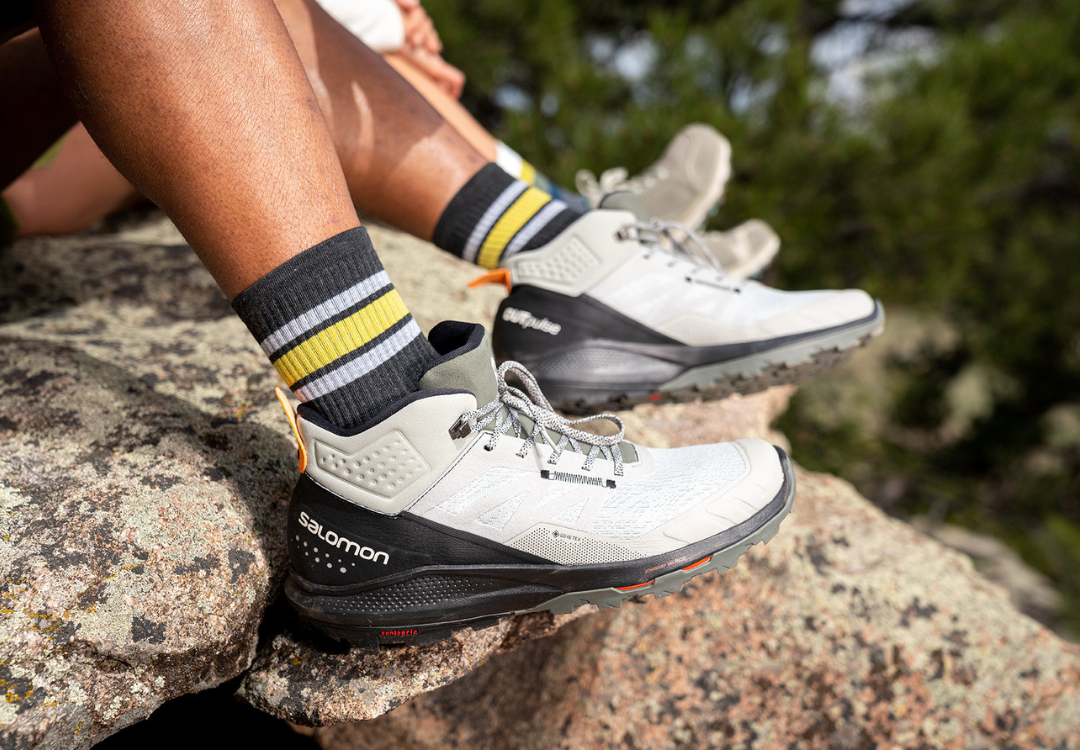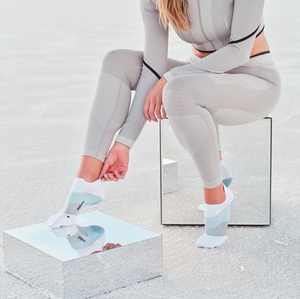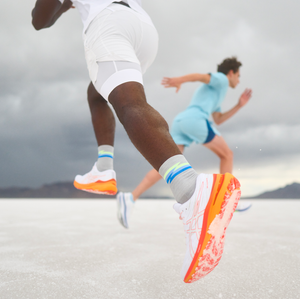In many parts of the country, hiking is a year-round activity, especially if you have suitable clothing and equipment. Warmer months require lightweight, breathable clothing to keep hikers cool and protect their skin from the sun's harmful rays. Cold weather requires layering from head to toe.
This guide to what to wear hiking in every season will ensure you're prepared for the elements in spring, summer, fall, or winter.

The Importance of the Right Clothing for Hiking
What you wear for hiking can make or break your experience. Most avid hikers recommend steering clear of cotton and denim. Cotton absorbs moisture, making it heavy and taking longer to dry than other materials, like Merino wool or silk.
Your favorite jeans may be comfortable for daily wear but are also not ideal for hiking. Jeans take a long time to dry when wet or sweaty and can cause painful chafing. Chafing can even lead to open sores and infections.
Moisture-wicking, water-resistant clothing is the most ideal for hiking, as it is generally lightweight, comfortable, breathable, and quick-drying. Choosing the best fabrics and clothing will make your hiking adventures more enjoyable.
Hiking Shoes
A quality pair of hiking shoes or hiking boots is essential no matter the season. The right footwear can make or break your hiking experience, and here's why:
Traction: Hiking shoes have more traction than fashion sneakers and running shoes, helping hikers grip rough, uneven, or wet terrain. This is vital for stability and safety on the trail.
Terrain-Specific Designs: Shop for hiking shoes based on the type of terrain you generally hike. Some designs have more grip for wet or icy conditions, while others are lighter with moderate traction for faster hikes or trail runs.
Protection: Hiking boots are bulkier but typically offer more traction. The higher top helps protect your ankles from sprains, as well as cold and trail debris. These are ideal for long hikes and backpacking.
Comfort for Shorter Adventures: Hiking shoes offer the appropriate amount of cushioning, comfort, and support for shorter adventures. They are generally more flexible and lighter than boots.
The Right Socks Matter: The comfort and performance of your hiking boots or shoes can be significantly enhanced with the right pair of socks. Feetures' hiking socks for men and hiking socks for women are engineered to fit seamlessly with your footwear, providing additional cushioning, moisture-wicking properties, and support. This synergy between sock and shoe can reduce friction, prevent blisters, and improve the overall feel and comfortability of the hiking boot or shoe.

Weather-Specific Hiking Attire
When you're out on the trail, the weather can be as unpredictable as the terrain itself. That's why it's essential to prepare for all conditions, whether it's a sudden downpour, gusty winds, or relentless sun. At Feetures, we understand that the right attire can make or break your hiking experience. Here's how to gear up for whatever Mother Nature throws your way:
Preparing for Rainy Conditions
Rain doesn't have to dampen your hiking spirits. With the right gear, you can embrace the elements and enjoy the unique beauty of a rain-soaked trail. Look for water-resistant or waterproof jackets and pants that allow for breathability. Pair them with Feetures' moisture-wicking socks, designed to keep your feet dry and comfortable, even when the skies open up. Remember, a wet hike doesn't have to be a miserable one; it's all about having the right gear.
Dressing for Windy Trails
Windy conditions can chill you to the bone if you're not properly dressed. Layering is key here. Start with a moisture-wicking base layer to keep sweat away from your skin, add an insulating mid-layer for warmth, and finish with a windproof outer layer. Feetures' socks, with their targeted compression and cushioning, provide the support and comfort you need to face the wind head-on. Don't forget a wind-resistant hat and gloves to protect your extremities.
Sun Protection Strategies
The sun's rays can be just as challenging as rain or wind, especially at higher altitudes. Protecting your skin is crucial. Opt for lightweight, breathable fabrics with built-in UV protection. Wide-brimmed hats, sunglasses, and sunscreen are also essential. And don't overlook your feet! Feetures' Elite Ultra Light socks offer a custom-like fit that's perfect for hot, sunny hikes. They're designed to wick moisture away, keeping your feet cool and dry.
Basics of Layering When Hiking
Layering is more than a fashion statement; it's a strategic approach to dressing that allows hikers to adapt to changing weather conditions. At Feetures, we understand that the trail can be unpredictable, and we're here to help you prepare for anything. Here's how to master the art of layering for your next hiking adventure:
Base Layer: The Foundation of Comfort
The base layer is all about moisture management. It includes undergarments, long underwear, and hiking socks that wick sweat away from your skin. Merino wool is a favorite for cold conditions, while synthetic fabrics excel in warmer weather. Feetures merino wool socks for men and merino wool socks for women are designed to keep your feet warm and dry, providing the perfect foundation for your hiking attire.
Mid Layer: Insulation and Versatility
The mid-layer is where you can get creative and versatile. Think light jackets, fleece, hoodies, vests, or even a thin-down jacket. This layer provides insulation, trapping heat to keep you warm. It's also where you can play with different combinations to suit the day's weather. Remember, the mid-layer is about balance; you want warmth without bulk.
Outer Layer: Protection from the Elements
Your outer layer is your shield against wind, rain, and snow. Whether it's a waterproof rain jacket or a warm, wind-resistant coat and the right hiking boot or shoe, this layer is all about protection. Consider the weather forecast and pack accordingly.
Accessories: The Finishing Touches
A brimmed hat, sunglasses, gloves, and scarf can make a world of difference. These accessories protect your face and eyes from the sun, prevent sunburn, and add an extra layer of comfort. They're the finishing touches that complete your layered look.
Pack Smart: Be Ready for Anything
Bring along a hiking pack to store unwanted layers as you shed them. The weather can change in an instant, and having a place to stash extra clothing is essential. Research the weather forecast before you head out and pack additional layers in case of sudden changes.
What to Wear Hiking in Spring
Spring hiking presents its own unique challenges and opportunities. With the landscape coming to life, it's a beautiful time to explore, but the weather can be unpredictable. Expect wet conditions, as temperatures can vary between cold, winter-like conditions and humid pre-summer weather. Mud is common on the trails during spring, so it's best to come prepared with water-resistant or waterproof clothing.
Layering in Spring
Layering is more than a suggestion in spring; it's essential. Weather conditions can change rapidly, and having the ability to easily shed or add layers will keep you comfortable. Start with moisture-wicking undergarments, add a lightweight fleece jacket for warmth, and top it off with a waterproof jacket to shield against sudden showers. Don't neglect your legs; waterproof pants and gaiters can help keep your lower body warm and dry, protecting against mud and puddles.
Foot Protection
Your feet are your foundation on the trail, and the right socks make all the difference. Feetures Merino 10 Merino wool socks are designed to keep feet warm and dry when hiking weather is wet and chilly. With targeted compression and anatomical design, these socks provide support where you need it most. Pair your socks with waterproof hiking boots or shoes that provide good traction. Spring trails can be slippery, and the right footwear will help you navigate with confidence.
Spring Hiking Companions
Accessories also play a vital role in spring hiking. A brimmed hat can shield you from both rain and sun, while moisture-wicking gloves can keep your hands warm on cooler days. Consider carrying a lightweight backpack with extra layers, snacks, and hydration. Spring weather can be fickle, and it's wise to have essentials on hand.
Finally, don't forget to embrace the season and enjoy the unique beauty of spring on the trails. From blooming wildflowers to the fresh scent of rain, spring hiking offers sensory delights that are worth savoring. Whether you're a seasoned hiker or just starting out, the right preparation and gear can make your spring hiking experience truly unforgettable.

What to Wear Hiking in Summer
Summer hiking is all about embracing the warmth and sunshine. It's a season filled with vibrant landscapes, abundant wildlife, and the joy of hiking in warm weather. Whether you're exploring a sun-drenched meadow or following a trail beside a sparkling stream, summer hiking offers a unique and delightful experience.
Choosing the Right Fabrics
The key to a successful summer hike starts with choosing the right fabrics. Opt for lightweight, breathable materials like nylon and polyester that wick moisture away from your skin, keeping you cool and dry.
Light colors that reflect heat are also a smart choice. While layering is still important in summer, it's all about keeping things light and airy. Consider moisture-wicking undergarments, shorts or lightweight pants, and moisture-wicking t-shirts. A packable rain jacket is a good idea for unexpected showers.
Foot Protection in the Summer
Your feet are your foundation on the trail, and the right socks can make or break a summer hike. Feetures Elite Ultra Light and Merino 10 socks are designed with summer hiking in mind. They're durable, moisture-wicking, and lightweight, with a custom-like fit that feels just right. Pair them with breathable hiking shoes or sandals for the ultimate comfort.
Summer Hiking Essentials
Summer hiking usually means lots of sun, so don't forget to shield yourself. Wear a brimmed hat and sunglasses to protect your skin and eyes, and apply sunscreen on exposed areas. Consider a lightweight scarf or neck gaiter for additional coverage.
Staying hydrated is crucial in the summer heat. High temperatures mean you'll likely sweat more, so carry plenty of water. Consider a hydration pack or water bottles, and don't hesitate to take frequent breaks to drink. Summer can also bring out bugs like mosquitoes and ticks. Wearing long sleeves and pants, using insect repellent, and tucking your pants into your socks can help keep them at bay.
Embrace the season and enjoy the vibrant green landscapes, abundant wildlife, and the joy of hiking in warm weather. Take the time to savor the sights, sounds, and smells of summer, and don't be afraid to take a refreshing dip in a trailside stream or lake. Even in summer, it's wise to carry a small backpack with essentials like snacks, a map, a first-aid kit, and an extra layer in case the weather changes.
What to Wear Hiking in Fall
Fall hiking is a sensory delight, with crisp air, vibrant foliage, and often perfect temperatures. Embrace the colors of the season as the leaves change on many hillsides and mountains, offering breathtaking views from summits. It's a time to enjoy the natural beauty, capture stunning photographs, and appreciate the tranquility of the trail.
Layering in Fall
Layering is key during this transitional season, as fall weather can be unpredictable. Start with moisture-wicking undergarments, add a short-sleeve t-shirt, an insulated vest or hoodie, and top with a zippered exterior jacket or rain jacket as needed. Consider hiking leggings or two-in-one pants that can convert to shorts for warmer days, allowing you to adapt to changing weather conditions. Don't overlook the importance of protecting your extremities. Cold fall days may require accessories like a hat and gloves
Foot Protection in the Fall
When it comes to fall hiking, your feet are your connection to the trail, and they deserve the utmost care and attention. Feetures Elite Merino 10 Max Cushion socks are specifically designed for the demands of autumn's unpredictable terrain. They provide insulation, durability, and high-density cushioning that's perfect for impact protection on rugged paths. Pair them with the right hiking boots for added ankle support or hiking shoes for lighter treks, and you'll be well-equipped for a comfortable and enjoyable fall hiking experience.
Fall Hiking Essentials
Prepare for your fall hike by staying hydrated and nourished by carrying enough water and packing energizing snacks. Pack smart, carrying a backpack with essentials like a map, compass, first-aid kit, extra layers, and a headlamp. Consider accessories like sunglasses or a neck gaiter for added comfort and protection.
Fall hiking offers a unique blend of comfortable temperatures, stunning scenery, and the chance to experience nature in a state of change. Be mindful of wildlife, as fall is a time when many animals are preparing for winter. Follow proper safety guidelines, especially in areas known for bears or other large mammals.
What to Wear Hiking in Winter
Winter hiking is a breathtaking experience, filled with the sparkle of fresh snow and the stillness of a landscape transformed. It's a season that offers unique challenges and rewards, requiring careful planning and thoughtful attire. Whether you're traversing a snow-covered forest or ascending a frosty peak, winter hiking invites you to embrace the beauty and serenity of nature's coldest season.
Understanding the Conditions
Always check local weather reports and trail conditions to prepare for snow, sleet, ice, or mild temperatures. Winter hiking demands a keen awareness of the environment and a willingness to adapt to rapidly changing conditions.
Layering for Winter
Layering is an essential strategy for winter hiking, providing the flexibility to adapt to changing weather conditions. The base layer is all about insulation and moisture management, utilizing materials like Merino wool or synthetic fabrics that wick sweat away from the skin. This layer keeps you warm and dry, forming the foundation of your winter hiking attire.
The mid-layer, often consisting of a fleece or down-insulated jacket, adds warmth without sacrificing breathability. It's the layer that traps heat, keeping you cozy even as temperatures drop. The outer layer acts as your shield against harsh winter elements, including wind, rain, and snow. This layer typically consists of a waterproof and windproof jacket, gaiters, and perhaps a wool or fleece hat.
Choosing the Right Footwear in Winter
Insulated and waterproof boots with good traction are essential for winter hiking. Pair them with Feetures Merino 10 and Elite Light Cushion socks, one of the best socks for hiking in cold temperatures, to ensure comfortable and secure footing on icy or snowy trails.
Winter Hiking Essentials
Equip yourself with crampons, snowshoes, or hiking poles as needed. Consider additional safety gear and accessories like a brimmed hat and sunglasses to protect against the sun and wind.
Additionally, include extra clothing, food, a thermos with a hot drink, and emergency supplies in your backpack. Make regular stops to drink and eat high-energy snacks, and follow winter trail etiquette by respecting other trail users and following designated paths.
As we've explored the essentials of hiking attire for various seasons, one aspect that deserves special attention is the choice of socks. The right socks can enhance comfort, support, and protection on the trail. Let's delve into the details of how to choose the right hiking socks for your adventures:
Choosing the Right Hiking Socks
Understanding how to choose hiking socks can help you stay comfortable and dry on varying types of hikes in ranging weather conditions. Whether you're hitting the trails for a run or a hike, the right socks can make all the difference. At Feetures, we believe that great trail running socks are also exceptional hiking socks. Why? Because the demands are often the same: comfort, moisture management, and protection against the elements.
You may opt for lighter-weight trail running or hiking socks for shorter, less demanding hikes or hot weather. The best trail running socks offer cushioning for impact absorption, durability, compression zones, and a custom-like fit.
Avid hikers or trail runners often have their own preferences with sock height, but quarter and crew lengths help protect the ankles from trail debris and mud.
For those braving the coldest hiking conditions, opt for insulated and moisture-wicking to keep feet warm and dry. Our highly cushioned Merino wool socks are ideal for the coldest hiking conditions. Merino wool socks also dry quickly if they become wet due to snow, rain, or mud.

Opt for Quality Products and Recycled Materials
Choosing quality hiking clothing can improve your experience on the trails. Choose products from companies that emphasize the importance of durability and top-quality materials. Many top brands offer lifetime guarantees, allowing you to send products in for repairs to prolong their lives.
Hiking is all about enjoying the outdoors, so it's essential to choose products that value sustainability. Purchase products made from recycled materials whenever possible.
Feetures socks come with a Lifetime Guarantee. If they don't live up to your expectations, you can return them for a replacement pair with no questions asked. We also use recycled plastic from discarded plastic bottles in our products to reduce waste while creating the world's most comfortable and reliable socks.
It's Time to Hit the Trails
Avid hikers don't want to put their hiking boots away when the temperatures drop. Instead, they opt for layering clothing made from high-quality, insulating, and moisture-wicking materials.
Putting together your ideal hiking clothing also means researching the weather forecast, choosing function over style, and knowing the trail conditions. A trail that winds through streams will require more waterproofing, while desert hiking requires more protection from spiky plants and cacti.
Investing in the right hiking shoes, socks, and other clothing will help you stay comfortable, so you can get the most out of every hiking experience. Shop Feetures trail socks and hiking socks to outfit your feet with the support and comfort they need to go the distance or reach the summit.


Leave a comment